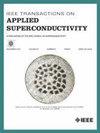Scalable Microwave SQUID Multiplexer Readout Architecture for TES-Based THz Security Camera
IF 1.7
3区 物理与天体物理
Q3 ENGINEERING, ELECTRICAL & ELECTRONIC
引用次数: 0
Abstract
In this article, we have developed a scalable superconducting quantum interference device (SQUID)-based microwave multiplexer (µMUX) readout architecture adapted for arrays of transition edge sensors (TESs) to be exploited in a terahertz security camera. The camera system combines a scanning optics together with a 128-pixel TES array and aims for security gate operations with a standoff detection distance of up to 25 m. The developed frequency-domain µMUX is used to read out all feed-horn-coupled TESs based on aluminum thermistors, with noise limited by intrinsic TES noise. Both the TESs and µMUXs are operated in a compact cryostat with a base temperature of about 0.9 K. The µMUX has been fabricated in the cross-type基于tes的太赫兹安全摄像机的可扩展微波SQUID多路复用读出架构
在本文中,我们开发了一种基于可扩展超导量子干涉器件(SQUID)的微波多路复用器(µMUX)读出架构,适用于太赫兹安全摄像机中使用的过渡边缘传感器(TESs)阵列。该摄像机系统将扫描光学器件与128像素TES阵列结合在一起,目标是在长达25米的对峙检测距离内进行安检门操作。所开发的频域μ MUX用于读取基于铝热敏电阻的所有馈电喇叭耦合苔丝,噪声受固有TES噪声限制。TESs和µmux都在一个紧凑的低温恒温器中工作,基本温度约为0.9 K。µMUX是在莱布尼茨光子技术研究所开发的交叉型$\text{Nb}/ \text{AlO}\_{\rm{x}}/ \text{Nb}$ Josephson结工艺中制造的,并结合了谐振频率在5-6 GHz范围内的高质量超导薄膜谐振器。相应实现的基于现场可编程门阵列的读出电子设备可以同时连续实时读出128 rf- squid,包括磁通斜坡调制方案。在使用铝制TES时,我们实现了约2.5美元的暗噪声等效功率;\text{fW}/ \text{Hz}^{1/ 2}$同时提供3.75 kHz的TES读出速率,这对于25hz的视频帧率是必要的。
本文章由计算机程序翻译,如有差异,请以英文原文为准。
求助全文
约1分钟内获得全文
求助全文
来源期刊

IEEE Transactions on Applied Superconductivity
工程技术-工程:电子与电气
CiteScore
3.50
自引率
33.30%
发文量
650
审稿时长
2.3 months
期刊介绍:
IEEE Transactions on Applied Superconductivity (TAS) contains articles on the applications of superconductivity and other relevant technology. Electronic applications include analog and digital circuits employing thin films and active devices such as Josephson junctions. Large scale applications include magnets for power applications such as motors and generators, for magnetic resonance, for accelerators, and cable applications such as power transmission.
 求助内容:
求助内容: 应助结果提醒方式:
应助结果提醒方式:


